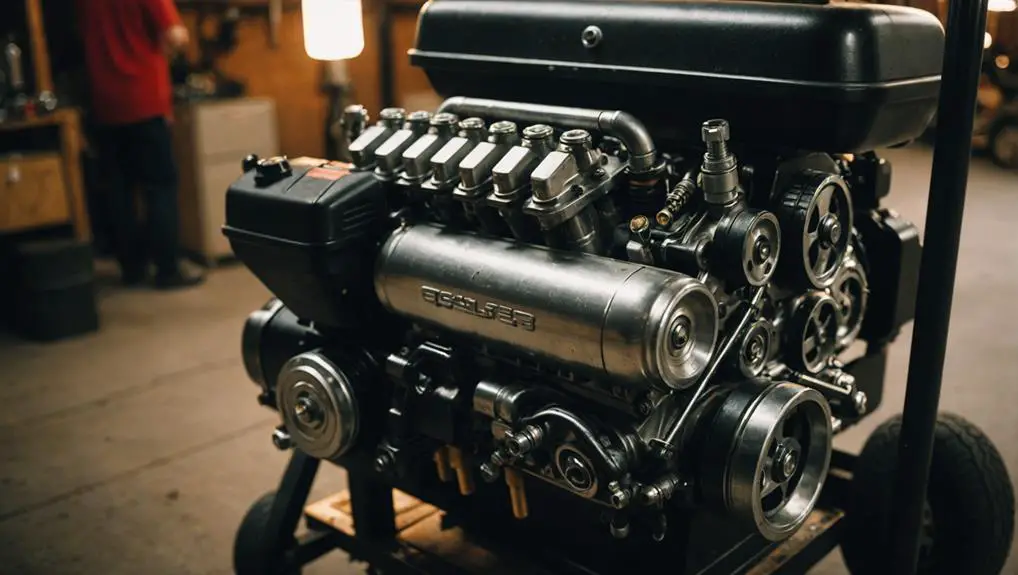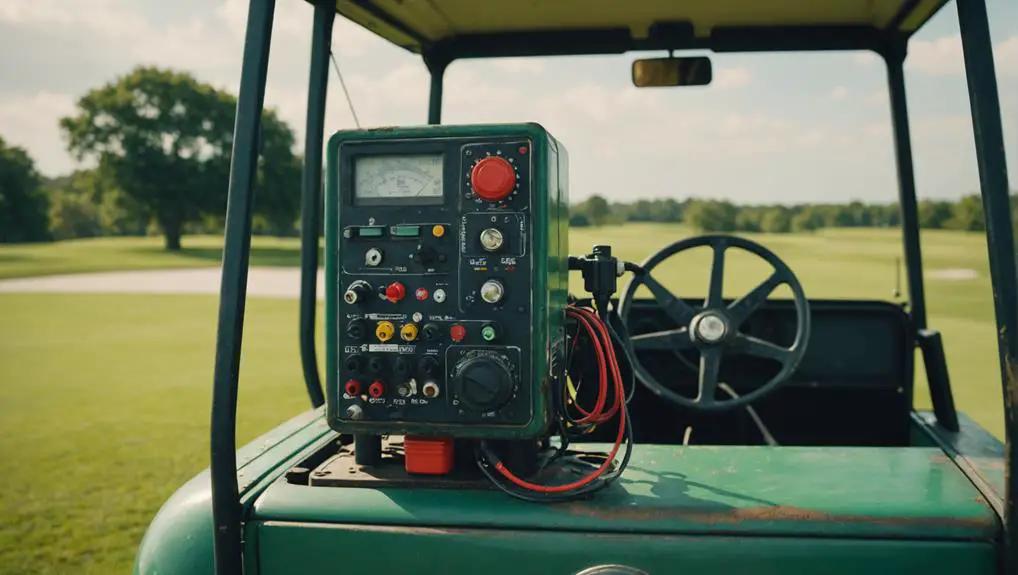Did you know that many Club Car gas golf cart issues can be traced back to simple maintenance oversights? When your cart sputters or loses power, it can be frustrating, but understanding the common problems can make troubleshooting much easier. From engine performance to electrical failures, knowing what to check first can save you time and effort. So, what are the key signs you should look out for, and how can you address them effectively? Let's explore these common issues and help you get your golf cart back on track.
Key Takeaways
- Inspect the air filter and fuel system for blockages to ensure proper airflow and fuel delivery to the engine.
- Check spark plugs for wear and proper gap to maintain efficient ignition and engine performance.
- Verify battery connections are tight and free of corrosion to prevent electrical issues and starting difficulties.
- Regularly clean and service the fuel system to enhance performance and prevent fuel-related problems.
- Schedule routine inspections and maintenance to ensure all components are functioning properly and to extend the cart's lifespan.
Engine Sputtering Issues
Engine sputtering in your Club Car gas golf cart can be frustrating and often indicates underlying issues that need addressing. One common cause is a dirty or clogged air filter. When the air filter becomes obstructed, it restricts airflow to the engine, leading to poor combustion and sputtering. Check the air filter regularly and replace it if necessary.
Another potential culprit is fuel-related problems. Inspect the fuel lines for any kinks or leaks that could restrict fuel flow. If the fuel filter is clogged, it can also impede fuel delivery, causing sputtering. Regularly replace the fuel filter according to your maintenance schedule.
Additionally, examine the spark plugs. Worn or fouled spark plugs can fail to ignite the air-fuel mixture effectively, resulting in sputtering. If you notice excessive deposits or wear, replace them promptly to restore engine performance.
Lastly, verify your golf cart has the correct fuel. Using low-quality or incorrect fuel can lead to engine issues, including sputtering. Always use fuel recommended by the manufacturer to keep your engine running smoothly.
Ignition Problems
When troubleshooting ignition problems in your Club Car gas golf cart, start by checking the spark plugs for wear or damage, as they play an essential role in starting the engine.
Additionally, inspect the battery connections to guarantee they're secure and free of corrosion, since poor connections can hinder electrical flow.
Addressing these issues promptly can restore your cart's performance and reliability.
Spark Plug Issues
Reliable ignition is essential for ensuring your Club Car gas golf cart runs smoothly, and spark plug issues can greatly disrupt this process.
If you're experiencing starting difficulties or poor performance, it's time to check your spark plugs. These components ignite the fuel-air mixture in your engine, so any issues can lead to significant problems.
Here are some common signs of spark plug issues:
- Fouled Spark Plugs: Excess carbon buildup can prevent proper ignition.
- Worn Electrodes: Over time, electrodes can erode, leading to weak sparks.
- Incorrect Gap: If the gap between the electrodes is too wide or too narrow, it can affect performance.
To troubleshoot, inspect the spark plugs for wear or damage. Clean or replace them as needed, ensuring they're gapped correctly according to your golf cart's specifications.
Additionally, check the ignition coil and wiring for any faults, as these can also contribute to spark plug issues.
Addressing these concerns promptly will help maintain peak engine performance and enhance your golf cart's reliability on the course.
Battery Connection Troubles
Battery connections play an essential role in the ignition process of your Club Car gas golf cart, and if they're loose or corroded, you might run into starting problems.
First, inspect the battery terminals. Look for any signs of corrosion, which appears as a white, powdery substance. If you spot corrosion, clean the terminals using a mixture of baking soda and water, and scrub gently with a wire brush.
Next, verify that the connections are tight. Loose connections can prevent the necessary voltage from reaching the starter. Use a wrench to tighten any loose nuts or bolts. If the cables feel frayed or damaged, replace them immediately to avoid further issues.
Also, check the battery's voltage using a multimeter. A fully charged battery should read around 12.6 volts or higher. If the voltage is lower, consider charging or replacing the battery.
Lack of Power

If your Club Car gas golf cart lacks power, you might be facing engine starting issues or fuel system blockages.
First, check whether the engine starts properly, as a weak ignition system can prevent it from firing.
Next, inspect the fuel lines and filters for any blockages that could restrict fuel flow to the engine.
Engine Starting Issues
Engine starting issues in a Club Car gas golf cart often stem from a lack of power, which can be frustrating when you're ready to hit the course.
When your engine won't start, it's crucial to identify the underlying problems quickly. Several factors contribute to power loss, and addressing them can help you get back on track.
Here are a few common causes to ponder:
- Weak Battery: A battery that's low on charge or nearing the end of its lifespan may not provide enough power to start the engine.
- Faulty Starter: If the starter motor is malfunctioning, it won't engage the engine, leading to starting issues.
- Electrical Connections: Loose or corroded battery terminals and wiring can hinder power transfer, preventing the engine from starting.
To troubleshoot, first check the battery voltage and connections.
If the battery's in good shape, inspect the starter and wiring. By systematically evaluating these components, you can pinpoint the source of the power issue and take the necessary steps to resolve it.
Keeping your engine in ideal condition guarantees a smooth ride on the course.
Fuel System Blockages
Fuel system blockages can severely impact your Club Car gas golf cart's performance, leading to a noticeable lack of power during operation.
When fuel can't flow freely, your engine struggles to generate the necessary power, resulting in sluggish acceleration and reduced speed.
Start by checking the fuel lines for any obstructions. Dirt, debris, or even kinks in the line can restrict fuel flow. Clear any blockages you find to restore proper fuel delivery.
Next, inspect the fuel filter. A clogged filter can prevent fuel from reaching the carburetor, so replace it if it appears dirty or old.
Don't overlook the fuel tank itself. Sediment can accumulate at the bottom, obstructing the fuel pick-up. If you suspect this, drain the tank and clean it thoroughly.
Additionally, verify that your fuel is clean and fresh. Old or contaminated fuel can also lead to performance issues.
Fuel System Troubles
A properly functioning fuel system is essential for the finest performance of your Club Car gas golf cart. If you're experiencing issues, you might be dealing with one of several common fuel system troubles.
Here's what to look for:
- Fuel leaks: Check for any visible leaks around the fuel lines and connections.
- Clogged fuel filter: A dirty filter can restrict fuel flow, starving the engine.
- Faulty fuel pump: Listen for unusual noises or check for weak pressure; this could indicate pump failure.
Start by inspecting the fuel lines for cracks or signs of wear.
Verify all connections are tight and secure. If you suspect a clogged fuel filter, replace it to restore peak fuel flow.
For the fuel pump, verify its operation by checking the pressure. If it's low or nonexistent, you may need to replace the pump.
Electrical System Failures

When you're cruising around in your Club Car gas golf cart and it suddenly loses power or won't start, electrical system failures might be the culprit.
First, check the battery connections; verify they're clean and tight. A loose or corroded connection can disrupt the flow of electricity. If the battery is old or discharged, it may need a jump or replacement.
Next, inspect the ignition switch. If it's faulty, it can prevent the engine from starting. A quick test with a multimeter can help determine if the switch is functioning correctly.
Also, pay attention to the fuses. A blown fuse can cut off power to essential components.
Locate the fuse box, and replace any blown fuses with ones of the same rating.
Maintenance Tips for Longevity
After addressing electrical system failures, it's important to focus on regular maintenance to guarantee your Club Car gas golf cart lasts for years.
Proper upkeep not only enhances performance but also prevents costly repairs down the line.
Here are some key maintenance tips:
– Change the Oil Regularly: Just like any engine, your golf cart requires regular oil changes to guarantee smooth operation.
Check your owner's manual for the recommended intervals.
– Inspect the Air Filter: A clean air filter guarantees peak engine performance.
Inspect and replace it as needed to prevent dirt and debris from entering the engine.
– Check Tire Pressure: Proper tire pressure is essential for safe handling and fuel efficiency.
Inspect your tires monthly and maintain the recommended PSI.
Frequently Asked Questions
How Often Should I Change the Oil in My Golf Cart?
You should change the oil in your golf cart every 100 hours of operation or at least once a year, whichever comes first.
Regular oil changes keep your engine running smoothly and extend its lifespan. Make certain to use the manufacturer-recommended oil type to guarantee peak performance.
Always check the oil level regularly and replace the oil filter when you change the oil to maintain efficiency and reduce wear on the engine components.
What Type of Fuel Is Best for My Gas Golf Cart?
For your gas golf cart, using unleaded gasoline with an octane rating of 87 or higher is best.
Avoid ethanol blends over 10%, as they can cause engine problems and fuel system issues.
Regularly check fuel quality, ensuring it's fresh and clean before filling up. This will help maintain your cart's performance and longevity.
Always consult your owner's manual for specific recommendations regarding fuel types and maintenance practices.
Can I Use Regular Car Parts for My Golf Cart Repairs?
Sure, you could slap some regular car parts on your golf cart and hope for the best—just like using a rubber band to fix a leaky pipe!
However, it's not that simple. Golf carts have unique specifications, so using parts not designed for them can lead to poor performance or damage.
Stick to parts made for your golf cart to guarantee safety and reliability. Your ride deserves better than a makeshift fix!
How Do I Store My Golf Cart During Winter Months?
To store your golf cart during winter months, start by cleaning it thoroughly to prevent corrosion.
Charge the battery fully and disconnect it to avoid drainage.
Inflate the tires to the recommended pressure and cover your cart with a breathable cover to protect it from dust and moisture.
Are There Aftermarket Modifications That Improve Golf Cart Performance?
Yes, there are several aftermarket modifications that can enhance your golf cart's performance.
You can upgrade the motor for increased torque and speed, install a high-performance controller to improve responsiveness, and add a better battery system for longer range.
Additionally, you might consider upgrading the tires for better traction and handling.
These enhancements can greatly boost your cart's capabilities, making it more enjoyable for you on the course or around your community.
Conclusion
To summarize, effectively troubleshooting your Club Car gas golf cart can save you time and money while ensuring peak performance. Did you know that regular maintenance can increase the lifespan of your golf cart by up to 25%? By systematically addressing engine sputtering, ignition issues, and fuel system problems, you'll enhance reliability and enjoy a smoother ride. Stay proactive with maintenance, and you'll keep your cart in top shape for years to come.